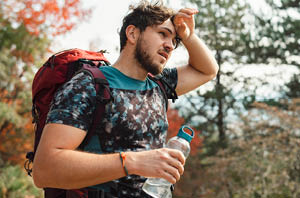What to watch out for and what you can do about heat exhaustion
Have you spent long periods of time in the sun without proper hydration? Have you felt dizzy, nauseous, or had a headache after heat exposure? If so, you may have experienced heat exhaustion. Read more about the 10 warning signs of heat exhaustion, what you can do to remedy it and how to prevent future episodes.
What is heat exhaustion?
Heat exhaustion is a common condition that can occur when your body is exposed to high temperatures for extended periods. It happens when the body is unable to regulate its temperature properly, leading to dehydration, exhaustion, and other symptoms like headache and nausea. It’s important to recognize the signs of heat exhaustion early to avoid more serious complications like heat stroke. ullamcorper mattis, pulvinar dapibus leo.
Imagine this scenario…
John is a construction worker who has been working outside on a hot and humid day for several hours without taking breaks or drinking enough water. He feels extremely tired and thirsty, and his clothes are soaked with sweat. He has a headache and feels lightheaded, with occasional bouts of dizziness. John’s skin is cool and clammy to the touch, and he’s having trouble concentrating on his work. He’s starting to feel nauseous and may need to vomit.
John may be experiencing heat exhaustion due to prolonged exposure to high temperatures and dehydration. He should stop working immediately and move to a cool, shaded area to rest and rehydrate with water or an electrolyte drink. He should also seek medical attention if his symptoms do not improve or worsen.
If John had known the warning signs, he could have prevented feeling so sick from heat exhaustion.
10 ways to recognize heat exhaustion
- Excessive sweating: If you notice that you’re sweating more than usual, it may be a sign of heat exhaustion. Excessive sweating is your body’s way of trying to cool down.
- Dehydration: Dehydration is one of the most common signs of heat exhaustion. It occurs when your body loses more fluid than it takes in, leading to dry mouth, thirst, and dark urine.
- Muscle cramps: Heat exhaustion can cause muscle cramps, especially in the legs and abdomen. These cramps are often caused by dehydration and loss of electrolytes.
- Dizziness: Feeling dizzy or lightheaded is another common symptom of heat exhaustion. This occurs when your body’s blood vessels dilate, causing blood to pool in your legs and feet.
- Nausea: Nausea and vomiting are often associated with heat exhaustion. Your body is trying to rid itself of toxins and prevent further damage.
- Headaches: Headaches are a common symptom of heat exhaustion. They occur when your body’s blood vessels dilate, causing increased blood flow to your brain.
- Rapid heartbeat: Heat exhaustion can cause a rapid heartbeat, also known as tachycardia. This occurs when your body tries to compensate for the loss of fluid and electrolytes.
- Fatigue: Feeling tired and weak are additional symptoms of heat exhaustion. Conserving energy and attempting to regulate your temperature are top priorities for your body.
- Cool, clammy skin: When your body is overheated, it may try to cool down by sweating. However, if you’re experiencing heat exhaustion, it may not be able to produce enough sweat, leading to cool and clammy skin.
- Confusion: In severe cases, heat exhaustion can cause confusion and disorientation. Confusion occurs when your brain doesn’t receive enough oxygen and nutrients due to decreased blood flow.
Medical Diagnosis
If you need medical care due to heat exhaustion, your family medicine physician may take your temperature to confirm the diagnosis and rule out heatstroke. If your provider suspects your heat exhaustion may have progressed to heatstroke, you could need further tests, including:
- A urine test to check your urine. The test can also check kidney function, which can be affected by heat stroke.
- A blood test to check for the content of gasses, as well as the sodium and potassium levels in your blood.
- Muscle function tests to check for rhabdomyolysis, (occurs when damaged muscle tissue releases its proteins and electrolytes into the blood.)
- X-rays and other imaging to check for damage to your inner organs, (in severe cases.)
What to do if you have heat exhaustion
In most cases, you can treat heat exhaustion yourself by doing the following:
- Rest in a cool place- resting in an air-conditioned area is best. If that’s not an option, sit in front of a fan or find some shade. Lay on your back with your legs raised above the level of your heart.
- Drink cold liquids– hydrate with water or sports drinks that contain electrolytes.
- Try cooling measures- take a cold shower, soak in a cool bath or put towels soaked in cold water on your skin. If you’re outside and these measures aren’t an option, soaking in a cool pond or stream can help bring your temperature down.
- Loosen clothing- take off any unnecessary clothing and make sure your clothes are not heavy or restrictive.
To cool your body to a normal temperature, your provider may utilize these heatstroke treatment techniques:
- Immerse you in an ice bath. Taking a bath in ice water has proven to be the most effective way of quickly lowering the core body temperature. The more quickly you can immerse yourself in cold water, the less risk you have of organ damage.
- Use evaporation cooling techniques. If cold water immersion is not an option, your care team may use an evaporation method to cool your body. Cool water is misted on your body while warm air is fanned over you. This causes the water to evaporate and cool your skin.
- Pack you with ice and cooling blankets. Another method to lower your temperature is to wrap you in a special cooling blanket and apply ice packs to your neck, back, groin area, and armpits.
- Administer medications to stop shivering. If attempts to lower your body temperature cause you to shiver, your provider may give you a muscle relaxant. Shivering increases your body temperature, making treatment less effective because it is working against the ultimate goal of cooling your body.
Remember heat exhaustion should not be taken lightly and can be a serious condition that requires prompt attention.
If you or someone you know is experiencing any of the symptoms of heat exhaustion, and are not successful in lowering body temperature, it’s important to seek medical attention immediately. We can help at Stellis Health, schedule an appointment today.
Preventing heat exhaustion
You can prevent heat exhaustion by being prepared before going out in the heat for prolonged periods. Do the following:
- Wear loose fitting, lightweight clothing. Restrictive or heavy clothing will inhibit the body’s ability to cool itself.
- Use sunscreen to protect against sunburn. Sunburns will add to your symptoms and increase your body temperature. Wear a wide brimmed hat and apply SPF15 sunscreen or higher. Remember to apply sunscreen more frequently when swimming.
- Stay hydrated. It is important to drink extra water when exposed to high temperatures because it helps your body sweat and maintain a normal temperature.
- Use caution with certain medicines when in the sun and heat. Check in advance if your medications interact adversely with the sun, or tend to cause dehydration.
- Never leave anyone in a parked car. Temperatures escalate in a closed car and it is extremely dangerous to be exposed to high temperatures. When parked in the sun, the temperature in your car can rise 20 degrees Fahrenheit in just 10 minutes!
- Take it easy during the hottest parts of the day. Plan for frequent breaks when working or exercising outside by finding shade and cooling down.Do your best to schedule strenuous outdoor activity in the cooler times of the day.
- Get acclimated to warmer temperatures. Limit the time you spend working in warmer temperatures. Gradually add minutes to time spent in hot weather. This will help your body acclimate to the hotter weather, and maintain a healthy body temperature.
- Be cautious if you’re at increased risk. If you take medications, have had prior heart ailments, or have had prior heat exhaustion or heat stroke, take care to be aware of symptoms early in order to avoid severe illness or hospitalization.
Use these reminders to prevent heat exhaustion. Stay safe and stay cool this summer!







